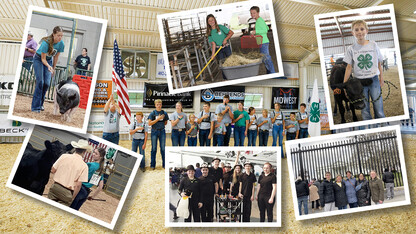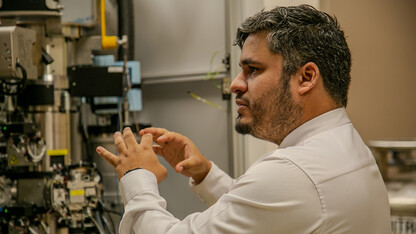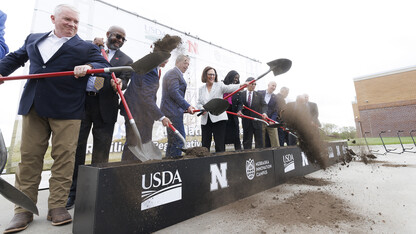· 5 min read
Forecast shows languid farm income won’t stall Nebraska economy

While weak farm income continues to be a soft spot for the state economy, Nebraska can expect growth through 2020 in several key sectors, according to the latest long-term economic forecast produced by the Nebraska Business Forecast Council and the University of Nebraska-Lincoln’s Bureau of Business Research.
Growing numbers of jobs in construction, agricultural processing and health care should offset weak growth in farm income, said Eric Thompson, an economist and director of the Bureau of Business Research.
Although annual farm income will remain significantly below the peaks seen in the early years of the decade, it is expected to rise slightly through 2020.
“Consequently, farm income should not detract from Nebraska economic growth, which should mirror stronger U.S. economic growth,” he said. “Nebraska should match U.S. job growth and see particularly strong growth in services, construction, retail trade and agricultural processing.”
The report is a first look at the prognosis for Nebraska’s economic growth into 2020.
Thompson and his fellow economists anticipate that Nebraska will add about 35,000 non-farm jobs from 2017 to 2020, the majority in the services sector. At an average annual increase of a little over 1 percent, Nebraska’s total employment would reach 1.06 million in 2020. Non-farm personal income should grow at a rate of about 4 percent a year, exceeding projected inflation rates ranging from 1.6 percent in 2020 to 1.8 percent in 2018.
The services sector represents 39 percent of Nebraska jobs as of 2017. It includes Nebraska’s largest employer, health care. Thompson said a combination of population growth, income growth and Nebraska’s aging demographics should contribute to health care growing by about 1.5 percent per year through 2020, although restructuring of hospital systems will limit how much the sector will grow.
The forecast also predicts more jobs in other parts of the services sector. Professional and business services, as well as entertainment and hospitality jobs, should increase, fueled by more commercial activity and expansion of technology companies. Higher incomes and lower fuel prices should encourage people to spend more money on leisure activities, spurring growth in hospitality-related industries. Overall, Thompson predicted that Nebraska would add about 20,000 services jobs by 2020.
Construction, agricultural processing and retail trade also will be areas of job growth.
In fact, one factor hampering Nebraska economic growth continues to be a shortage of workers, more than a shortage of jobs. Manufacturers and the trucking industry face a shortage of workers with the skills needed for their jobs. Despite worker shortages, hourly wage growth will remain modest because of a highly competitive business environment, Thompson reported.
Construction continues to benefit from the State Legislature’s decisions several years ago to dedicate more state tax revenue to road-building. In addition, more home construction is anticipated for Omaha, Lincoln and some smaller cities that have promoted housing development. The construction sector is expected to add 4,000 jobs over the next three years, with annual increases ranging from 2.5 percent to 3 percent.
Agricultural processing, such as a chicken processing plant planned for the Fremont area, is expected to add jobs in non-durable goods manufacturing. However, weak demand for farm machinery and equipment will hamper growth in durable goods manufacturing.
Retail sales are expected to grow, but probably won’t produce an equivalent number of jobs because of the surge in online sales and labor-saving strategies such as self checkouts and supply chain management efficiencies.
Little growth is expected in the transportation industry. The rail sector remains under pressure because the electric utility industry’s shift away from coal-fired plants has reduced demand for coal hauling, while the trucking industry faces a shortage of long-haul drivers.
The information industry has seen substantial increases in labor productivity – which is good for the economy, but bad for job growth. The expansion of technology companies and increasing access to high-speed internet will support about 100 new jobs per year.
State and local government, another major employer in Nebraska, will see little growth through 2020. That’s partly because the workers who were hired during significant government expansions in the 1960s and 1970s are now reaching retirement age and improved productivity means some retirees will not need to be replaced.
Farm income, which dropped 49 percent from 2013 to 2016, began to stabilize and recover in 2017. It is predicted to exceed $4.2 billion in 2018, a nearly 6 percent increase from 2017, but is expected to grow little more in 2019 and 2020.
Along with Thompson, other members of the Nebraska Business Forecast Council are John Austin, retired from the Bureau of Business Research; David Dearmont, Nebraska Department of Economic Development; Phil Baker, Nebraska Department of Labor; Ken Lemke and Scott Loseke, Nebraska Public Power District; Brad Lubben, University of Nebraska-Lincoln Department of Agricultural Economics; and David Rosenbaum, University of Nebraska-Lincoln Department of Economics and Bureau of Business Research.
To read the full Business In Nebraska December 2017 long-term economic forecast, click here.








